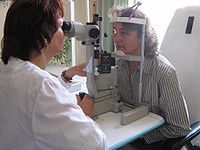
Photo from wikipedia
Aim Gonioscopy is used to exam the anterior chamber angle and the neighbouring structures. Gonioscopy can be performed using a contact lens, with the patient sitting at the slit lamp… Click to show full abstract
Aim Gonioscopy is used to exam the anterior chamber angle and the neighbouring structures. Gonioscopy can be performed using a contact lens, with the patient sitting at the slit lamp or in a supine position. Due to the total inner reflection of the cornea, the anterior chamber angle would otherwise be invisible in a healthy eye. During normal daily clinical routine, gonioscopy is often omitted, due to lack of time, although additional information could be gained. Materials and Methods The aim is to give a summary of the diagnostic possibilities using gonioscopy and to emphasise the importance of this relatively easy clinical method. Results The development of gonioscopy, the appropriate tools, proper procedure at the slit lamp and the most popular grading systems are described. In addition, an overview of detectable pathological changes in the anterior chamber angle is given and future prospects about developments in gonioscopy. Conclusion Gonioscopy can provide additional information otherwise missed by slit lamp examination or ophthalmoscopy alone. Up to now, no (semi-)automatic devices have been developed which could completely replace gonioscopy. Therefore gonioscopy remains an important part of a complete ophthalmological examination and should be learned, mastered and performed regularly by every ophthalmologist.
Journal Title: Klinische Monatsblatter fur Augenheilkunde
Year Published: 2017
Link to full text (if available)
Share on Social Media: Sign Up to like & get
recommendations!